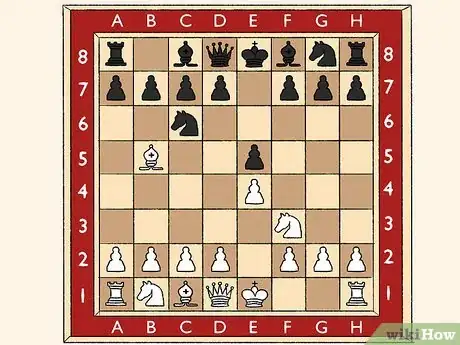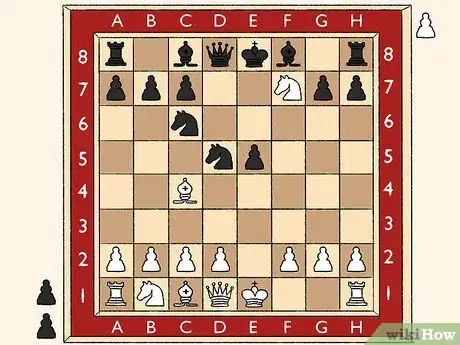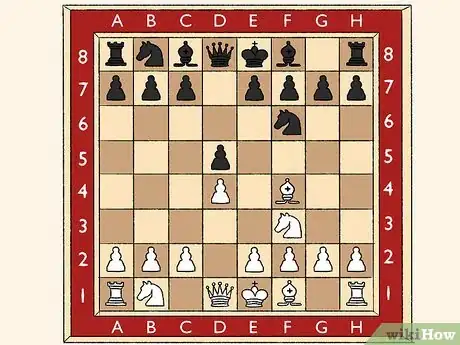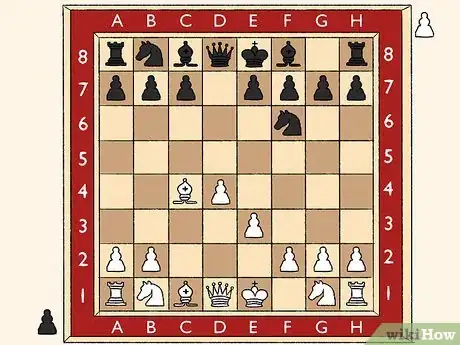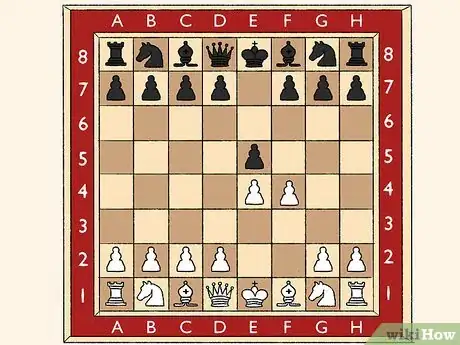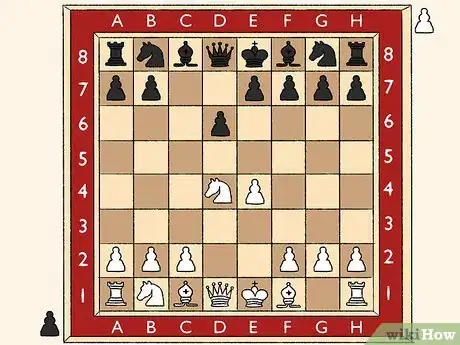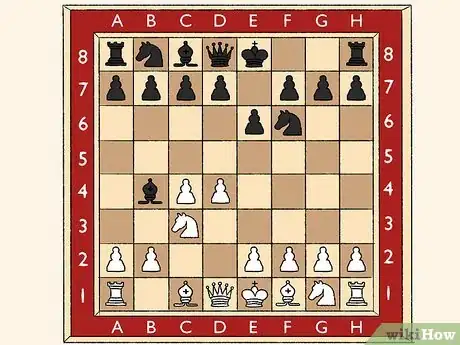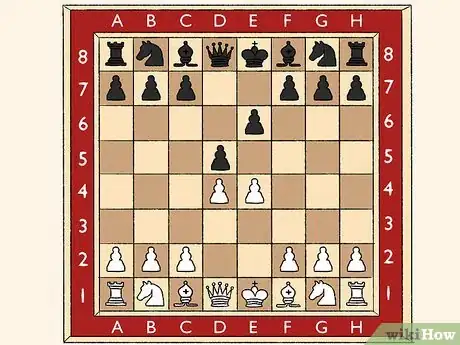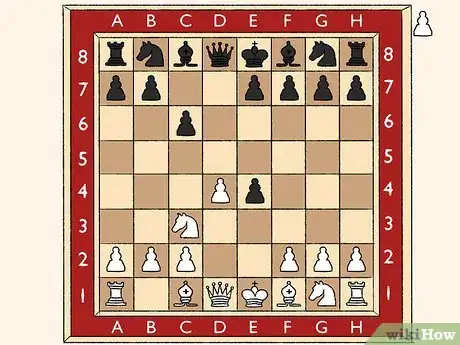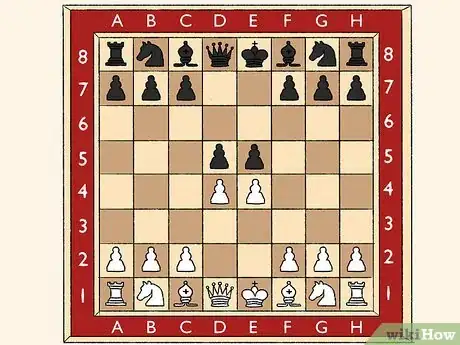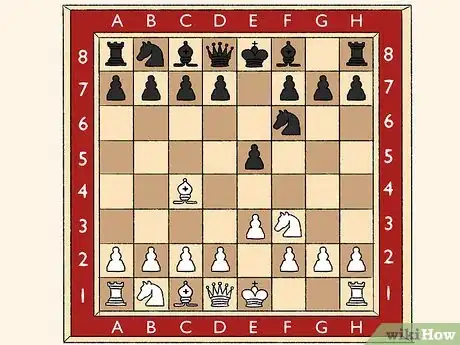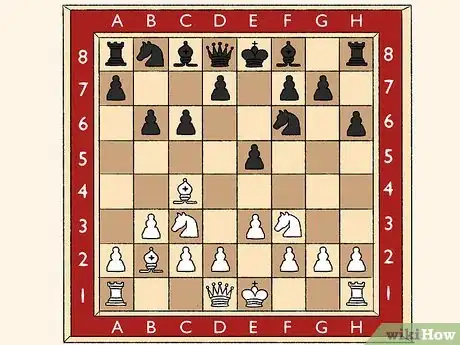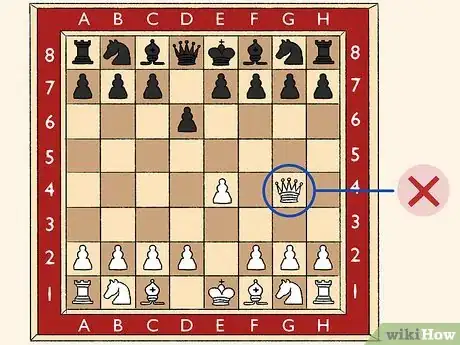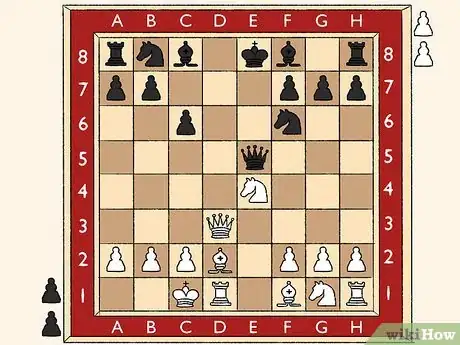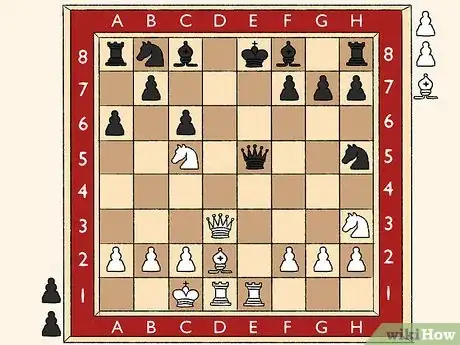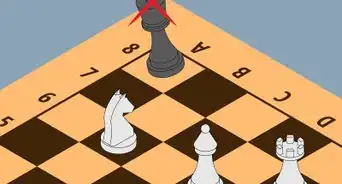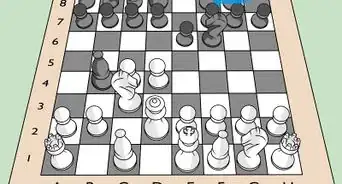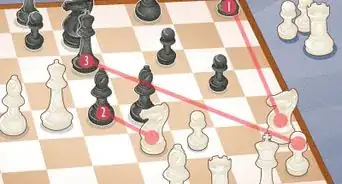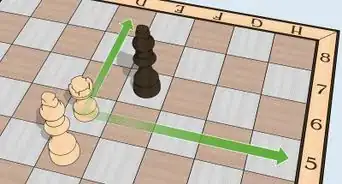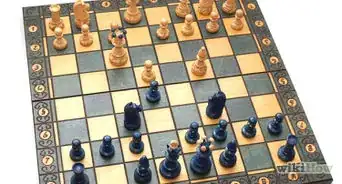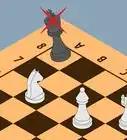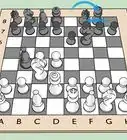This article was co-authored by Vitaly Neimer and by wikiHow staff writer, Hunter Rising. Vitaly Neimer is an International Chess Master and Certified Professional Chess Coach with over 15 years of training experience. He has been a part of the United States' Webster SPICE national chess champion team and is also a two-time Israeli national chess champion.
There are 12 references cited in this article, which can be found at the bottom of the page.
wikiHow marks an article as reader-approved once it receives enough positive feedback. In this case, 93% of readers who voted found the article helpful, earning it our reader-approved status.
This article has been viewed 230,289 times.
The opening plays in chess are critical to setting up your strategy for the rest of the game. If you advantageously position more pieces earlier than your opponent does, you’ll have better control of the endgame and are more likely to win. As long as you memorize a few openings and pay close attention to your opponent’s moves, you can gain the upper hand!
Note: This article presumes your opponent’s plays based on known chess strategies. Your opponent may play differently than the moves that are listed here.
Steps
Playing as White
-
1Use the Ruy Lopez opening to free up your bishop and knight. Start by advancing your king’s pawn 2 spaces forward to the e4 square to take control of the center. In the mainline variant, your opponent will mirror your play and move to e5. Develop your king’s knight to the f3 space to put pressure on your opponent’s pawn. Your opponent will usually move their queen’s knight to c6 in response. Then, move your king’s bishop diagonally to b5 so you can attack the knight next turn.[1]
- Pawns can only advance 2 spaces the first time they move.
- Development refers to moving your more powerful pieces out from the back row and toward the center of the board.
- This opening allows you to easily maneuver across the board while freeing up the space between your rook and king so you can castle, which is when you move your king next to your rook and then put the rook on the opposite side. This helps protect your king.
-
2Open with the Fried Liver Attack line to draw out your opponent’s king. Start by moving your pawn to e4 and allow your opponent to advance their pawn to e5. Position your knight on f3 so your opponent moves their knight to c6. Then, develop your bishop to c4 to put pressure on your opponent’s king’s side. Your opponent will usually bring their other knight to f6 so you can move your knight to g5. Your opponent will typically advance their queen’s pawn to d5 so you can capture it with your pawn. Next, your opponent will capture your pawn with their knight, but you can capture f7 with your knight.[2]
- After that, your opponent will need to move their king to f7 to capture your knight, which will prevent them from building a strong defense. However, you will lose 1 knight early in the game.
Advertisement -
3Try the London System to force the black player into defensive positions. If you don’t want to lose pieces right away, develop your queen’s pawn on your first turn to d4. Your opponent will typically mirror your movement and advance their pawn to d5. Bring your king’s knight to f3 to protect your pawn and control the e5 square. Your opponent will mirror your move and develop their knight to f6. Then, move your queen’s bishop to f4 so you have additional control over the board.[3]
-
4Develop pawns on the queen’s side to attack with the Queen’s Gambit. Start by advancing your queen’s pawn 2 spaces forward to the d4 square to control the center. Your opponent will usually move their queen’s pawn to d5 in response. Then, move your pawn to c4 to put pressure on the pawn. Your opponent will usually capture the pawn on c4, but that’s okay. Advance your king’s pawn forward to e3 to free up your bishop. Your opponent will typically develop their knight to f6 so you can capture their pawn with your bishop.[4]
- The Queen’s Gambit refers to sacrificing a pawn that’s on the queenside, which puts pressure on the black player to respond more defensively for the rest of the game.
Variation: Your opponent may also move their pawn to b5 to protect the one on c4. If they do, advance your pawn to a4. This will make your opponent move their pawn to c6 for protection. Capture the pawn on b5 and allow your opponent to take yours. Then, you can move your queen to f3 to trap the rook on a8.
-
5Play the King’s Gambit to free up your queen and the king’s bishop. Start by advancing your king’s pawn forward 2 spaces to the e4 square so you have control over the center. If your opponent moves a pawn to e5, then develop another pawn to f4 to put pressure on your opponent. Typically, your opponent will capture the pawn on f4 to “accept” the gambit.[5]
- Even though you lost a pawn, there aren’t any pieces blocking the way for your queen or bishop to move across the board diagonally.
Defending as Black
-
1Use the Sicilian Defense to take the offensive early in the game. If the white player opens by moving their king’s pawn to the e4 square, move a pawn to c5 to control the d4 space. Your opponent will typically respond by developing their knight to f3. Move your queen’s pawn forward 1 space to d6 for control over the e5 space. If the white player advances their pawn to d4, capture it with the pawn from c5. Even though your opponent will probably capture your pawn with their knight, you still have good control over the board.[6]
- You're able to move your queen and bishop easily if you need to use them.
-
2Open with the Nimzo-Indian Defense to build a wall of pawns around your king. White might open by moving their queen’s pawn to d4 so they can control the center. Rather than mirroring their play, develop your knight to f6 so you can potentially capture on d5 and e4. If your opponent follows up by moving a pawn to c4, advance your king’s pawn to e6 to free up your bishop. When your opponent develops their knight to c3, move your king’s bishop to b4 to put pressure on your opponent’s pieces.[7]
- Leave your king’s rook and king in their starting squares so you can castle.
- If your opponent attacks your bishop on a3 with a pawn, capture their knight on c3 to put them in check, which means you can capture their king on your next turn. They will capture your bishop during their turn with a pawn, but the pawn will be stuck behind another one of their other pawns and won’t be able to move freely.
-
3Play the French Defense to put pressure on the queen’s side of the board. If your opponent opens by moving their king’s pawn to e4, advance your king’s pawn 1 space to e6 to immediately free up your bishop. Your opponent will usually respond by advancing their queen’s pawn to d4 so they have more control of the center. Mirror their play and move your pawn to the d5 square. While your opponent may be tempted to capture your pawn, you’ll be able to retake it right away.[8]
- In the French Defense, it will seem like you’re giving more control of the center to the white player, but you’ll be able to build a strong wall of pawns that defend your pieces.
Warning: Many times, your queen’s bishop will get trapped and have limited mobility until much later in the game.
-
4Try the Caro-Kann Defense to set up a strong pawn structure for the late game. Much like the Sicilian Defense, if your opponent opens by moving a pawn to e4, position one of your pawns in c6 to put some pressure on the d5 space. If your opponent follows up by moving a pawn to d4, respond by advancing a pawn to d5. The white player will typically move their knight to c3 for added defense. You can respond by capturing the pawn on e4 so you regain control of the center.[9]
- The diagonal wall of pawns on the queen’s side will help protect you later in the game and it frees up your bishop to attack the king’s side.
Learning General Strategy
-
1Aim to control the center squares of the board. If you have pieces in the center 4 squares (d4, d5, e4, and e5), then your opponent will have a difficult time maneuvering their pieces without putting them at risk.[10] Try to move either your king or queen’s pawn into the center and set up your other pieces so they can capture on those squares. The longer that you can maintain control of the center, the more likely you are to win the entire game.[11]
- For example, if you’re the white player and you move your knight to f3, you can capture pieces on d4 and e5.
-
2Develop your knights and bishops forward to free them up.[12] Rather than trying to move all of your pawns right away, bring out at least 1 bishop and knight from the back row so they’re closer to the middle of the board. This helps you gain mobility around the board and puts more pressure on your opponent’s pieces.[13]
- Remember, knights can jump over other pieces so you can advance them without moving a pawn out of the way.
Tip: Keep your rooks in the corners during the first few turns since they’re more powerful than the knights and bishops.
-
3Try to move different pieces with each turn. While you’re moving the same piece, your opponent may develop more of their pieces to the center and take control of the board. As you start your game, switch between which pieces you move until you have a strong board presence. Get as many pieces off of their starting squares as you can so it’s easier for you to get around the board.[14]
- If you can capture an enemy piece other than a pawn, it’s okay to use a piece you already moved. Otherwise, you can continue developing other pieces.
-
4Save your queen for big plays later in the game. It can be really tempting to move your queen early in the game since it’s so powerful but don’t risk losing it just yet. Keep your queen near the back row and protected by your other pieces so it doesn’t get attacked right away. That way, you can use it during the endgame to maneuver around the board quickly and put pressure on a lot of squares.[15]
-
5Castle as soon as you can to protect your king.[16] Try to clear out all the pieces between one of your rooks and your king within the first few turns of the game. As long as you haven’t moved your king or rook, you can slide the king so it’s in the square next to your rook. Then lift up your rook and put it on the opposite side of the king so your king is protected in the corner. This will make it more difficult for your opponent to attack.[17]
- You can castle with either the king’s or queen’s rook.
- Even though you’re moving 2 pieces, castling still only counts as 1 turn.
-
6Clear the spaces between your rooks so they can guard each other. After you castle, work to move all of the pieces between your rooks out of the back row. That way, your rooks are connected and protect each other.[18]
- If you can, try to line up one of your rooks with your opponent’s queen across the board to put pressure on it.
Community Q&A
-
QuestionWhat happens if I move the queen early?
 Keithman3Community AnswerThere's no written rule that says you can't, it's just a general advisement. Moving the queen early exposes it to attack, and if it is lost, your most powerful piece is no longer in your arsenal. As long as you know what you're doing, move the piece whenever you want.
Keithman3Community AnswerThere's no written rule that says you can't, it's just a general advisement. Moving the queen early exposes it to attack, and if it is lost, your most powerful piece is no longer in your arsenal. As long as you know what you're doing, move the piece whenever you want. -
QuestionShould I take black or white? When taking black, it is a little easier to read my opponent.
 DonaganTop AnswererIf given the choice, take white. White, in moving first, always has a very slight advantage over black. A skilled player, playing white, will maintain pressure on black throughout the game.
DonaganTop AnswererIf given the choice, take white. White, in moving first, always has a very slight advantage over black. A skilled player, playing white, will maintain pressure on black throughout the game. -
QuestionHow many Sicilian variations are they?
 Community AnswerAbout 20 to 30. The Sicilian is one of the most popular openings, and new novelties are always popping up.
Community AnswerAbout 20 to 30. The Sicilian is one of the most popular openings, and new novelties are always popping up.
Warnings
- Try not to play the same opening every time since your opponent will be able to predict your moves and counter them.⧼thumbs_response⧽
References
- ↑ https://www.chessstrategyonline.com/content/tutorials/introduction-to-the-chess-openings-ruy-lopez
- ↑ https://youtu.be/Txvz97tzDfM?t=183
- ↑ https://www.chess.com/openings/London-System
- ↑ https://youtu.be/HdHWAuQRG7E?t=51
- ↑ https://youtu.be/n5ImJ2row6E?t=44
- ↑ https://www.chessstrategyonline.com/content/tutorials/introduction-to-the-chess-openings-open-sicilian
- ↑ https://youtu.be/ljtOTHuFJxg?t=70
- ↑ https://youtu.be/rTNN7-Wwpzs?t=91
- ↑ https://youtu.be/uLfrt7Atldo?t=38
- ↑ Vitaly Neimer. International Chess Master. Expert Interview. 11 September 2019.
- ↑ https://exeterchessclub.org.uk/content/ten-rules-opening
- ↑ Vitaly Neimer. International Chess Master. Expert Interview. 11 September 2019.
- ↑ https://www.chessstrategyonline.com/content/tutorials/how-to-start-a-game-of-chess-opening-principles
- ↑ https://exeterchessclub.org.uk/content/ten-rules-opening
- ↑ https://www.chessstrategyonline.com/content/tutorials/how-to-start-a-game-of-chess-opening-principles
- ↑ Vitaly Neimer. International Chess Master. Expert Interview. 11 September 2019.
- ↑ https://www.chessstrategyonline.com/content/tutorials/how-to-start-a-game-of-chess-opening-principles
- ↑ https://exeterchessclub.org.uk/content/ten-rules-opening
